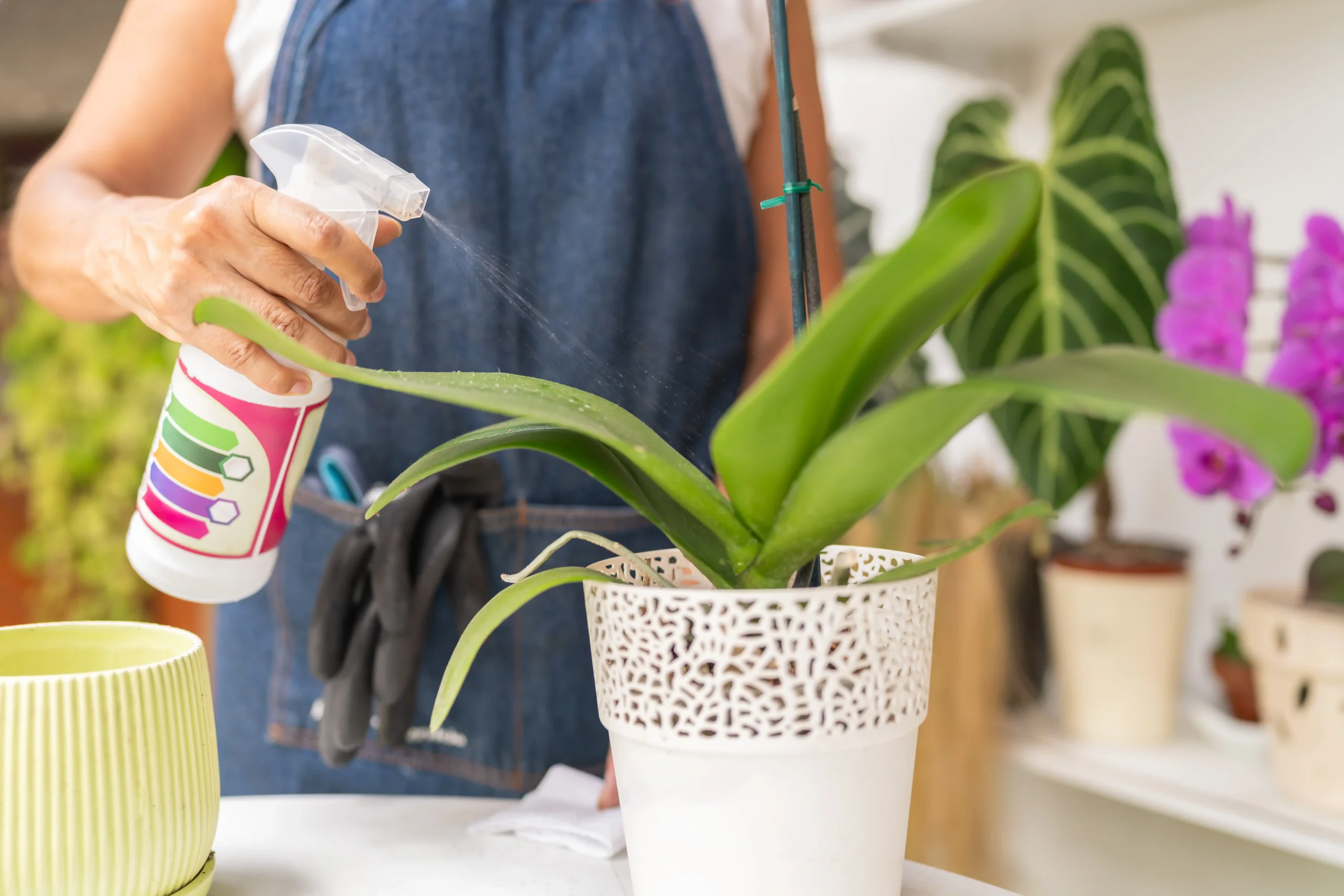The struggle to find “perfect” orchid fertilizer is real. The market is flooded with options and brands, selling mists, organic, liquid, slow-release, or water-soluble fertilizers.
Miracle-gro is one of them, with divided opinions among the orchid community. Some people love the convenience of its mist while others find it questionable due to vague instructions, ethical concerns, and risks for delicate roots.
Personally, MSU (13-3-15 and K-lite)is my go-to fertilizing formula for orchids and I’ve praised it time and again, for its balanced nutrients and proven results.
However, I recently tried Miracle-Gro on my Phals because I was curious (or maybe looking for something better) to see how it works for my orchids.
So, here, I’ll share my take on Miracle-gro orchid food and some valid opinions of fellow growers. I will also explore the mist formulation and slow-release spikes along with some tips on its effective use.
Table of Contents
The Problem of Regular Miracle-Gro Fertilizers
Miracle-Gro offers ready-to-use fertilizers and potting mixes to make gardening effortless for everyone. Their product range is huge with options for succulents, edibles, or simple houseplants.
But can you use Miracle-Gro’s “regular fertilizers” on your orchids?
The answer is NO. Before feeding any plant food to your lovely orchids, must keep in mind that they’re epiphytes that thrive in nutrient-poor environments.
It means they require weak or diluted fertilizers and over-feeding (strong fertilizing) can be a kiss of death for them.
So, do not feed “regular” formulas Miracle-Gro to your orchids. These fertilizers do not contain specific instructions (dosage and applications) for epiphytic plants and their concentrations can be too strong for your sensitive orchids.
Miracle-Gro Orchid Specific Fertilizers
Miracle-Gro orchid foods are formulas specially designed for orchids and other acid-loving plants. They include:
- Water-soluble orchid foods
- Ready-to-use food mist
- Plant food spikes (slow-release)
Before going into details, let me give you a quick overview of these fertilizer formulas and their applications as per the label:
| Miracle-Gro Orchid Food Mist | Miracle-Gro Plant Food Spikes | Miracle-Gro Water Soluble Orchid Food | |
| Form | Ready to use mist | Solid sticks (slow-release fertilizer) | Solid |
| Fertilizer Analysis (NPK Ratio) | 0.02-0.02-0.02 | 10-10-10 | 30-10-10 |
| Application | 2-3 short bursts of spray on every plant per application | 1-2 spikes for medium pots | ¼ tsp per gallon |
| How often to use | Every time you water your plant | After every 2 months during active growth | Twice a month during the plant’s active growth and once a month during the resting period |
Let’s dive into details and my take on each and then you can decide whether to use Miracle-Gro or not.
1. Miracle-Gro Ready-to-Use Orchid Plant Food Mist
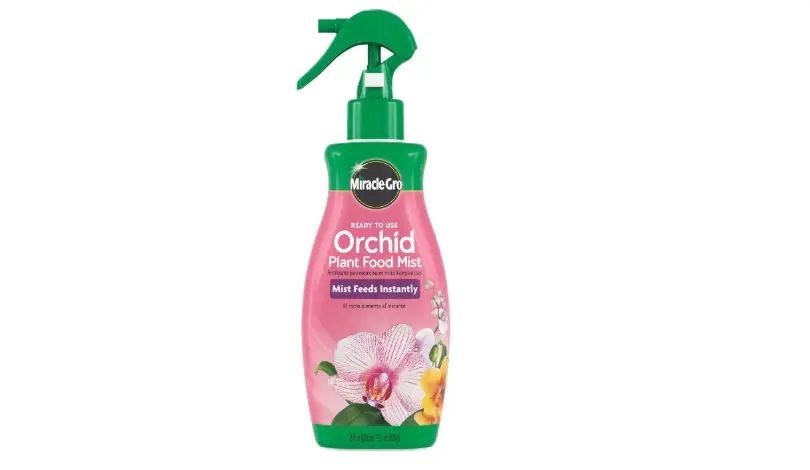
When you don’t have time to buy and mix fertilizer with water in exact proportions, the idea of a ready-to-use orchid mist really seems exciting, right? Well, that’s the case with me.
I tried it on my Phals and Cyms and sprayed 2-3 short bursts of spray around leaves once a week. It’s active growth period and 0.02-0.02-0.02 formula doesn’t seem to provide comprehensive nutrition for my orchids.
That’s why I paired it with my regular ferts (read my schedule here) while testing this. Still, I think it’s pretty usable in winter when fertilization needs are low. You can skip regular fertilizer at that time and rely on it with flushing after 3 weeks.
Caution: Do not use the mist on any bud or flower in bloom as it can be the last nail in the coffin of your flower.
The experience of fellow gardeners for this mist is altogether positive. It actually helped people with orchid blooms and leaves growth. However, some people find it pricey (I agree) as the NPK-ratio is low and a regular fert is definitely needed during active growth. So, the value it provides is limited to winter.
For me, Miracle-Gro orchid mist is fine. I found it convenient and easy to apply. The spray pattern isn’t properly centered and finding the correct angle takes a few tries. But my leaves are perked up and growing at an angle instead of being flat. I can also use it on a variety of my orchids, so it’s a great option if you want a quick fert.
- Convenient to use when you aren’t in the mood to mix your fert with water
- Helps with leaf growth and shine
- Best to use in winter (once a week) and flushing after 3 weeks
- A bit pricey (considering the very low NPK conc). You can buy a regular one instead and use it for a long time.
2. Miracle-Gro Plant Food Spikes
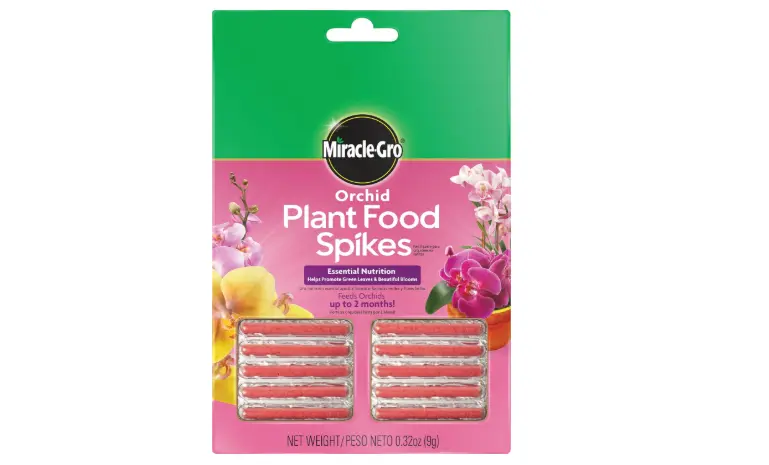
Miracle-Gro’s plant food spike is a slow-release fertilizer formula in the form of solid sticks, with an NPK ratio of 10-10-10 (equal parts of nitrogen, phosphorus, and potassium).
Instructions on the package indicate that you simply have to cut the spike in half and press it into the potting mix between the plants and the edge of the pot and you’re all set!
Also, the label says that spikes feed plants for up to 2 months, that is, to ensure continuous feeding of your orchids. You have to use the new ones after every 2 months.
However, from my experience with fertilizers, I would suggest you reduce the application rate by half during the winter months.
Pro-Tip: Feed your orchids with spikes only when they are in the active growth period, that is to say, only when new roots, shoots, and leaves are developing or flowers are blooming.
Personally, I’m not a fan of slow-release fertilizers because their nutrients are released only when they are exposed to water. I also have to pay a lot of attention to their temperature-release curve. Nutricote works better for me (which, I think, is less temperature sensitive) for fast-growing orchids like Cymbidiums.
For Miracle-gro spikes, I think they’re a good value for money if you have a lot of orchids. But use them on Cymbidiums, Catasetinae, or large Cattleyas as they require frequent watering.
They’re good for improving growth rates and are convenient to use, so using them with caution won’t be a bad bet.
- Easy to use: just put in potting mix and you’re done for 2 months
- Inexpensive, and few sticks can go a long way
- Sticks don’t disintegrate quickly or stick with potting mix.
- Not suitable for all varieties. Use them just on your hungry orchids (Cyms, Catts).
- Not suitable to use in winters.
3. Miracle-Gro Water-Soluble Orchid Plant Food
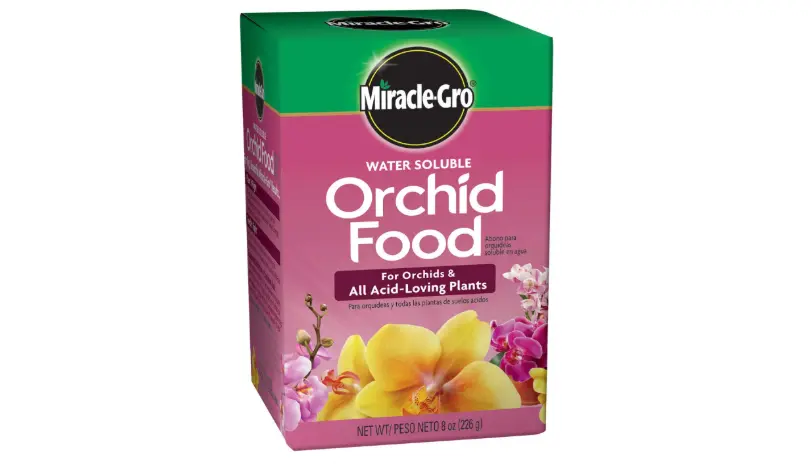
Another product of Miracle-Gro for acid-loving plants like orchids is a 30-10-10 water-soluble formula. The label of the product says mixing ¼ tsp of this formula per gallon of water (optimally with room temperature or a little warmer water) works well for orchids.
I prefer the weekly feeding approach. But, as per instructions on the label, this formula should be used twice a month during the plant’s active growth and once a month during the resting period.
From what I’ve gathered, miracle-gro water-soluble food seemed to be working well for some cultivators, (if given the appropriate dosage, along with quality potting mixes).
However, a lot argue that the product contains a very high percentage of urea-based nitrogen (27%) and nitrates are just 3%. The N-availability through urea or other forms is a long debate, but I think concentration matters more, and you should aim for 75-125ppm N. Don’t worry too much about urea or nitrates.
I’ve tried this fertilizer on Phalaenopsis but I wasn’t confident enough for Vanda or Dendrobium orchids. It’s a bit strong and I would advise you to apply half of the recommended dosage to prevent your orchid roots from burning.
For Phal, the leaves got fuller and I’m hoping to see buds soon. The price point is great too and I’ll update you more once it blooms.
- Great for reviving dormant orchids after a resting period.
- Affordable price.
- Promotes vegetative growth due to high N.
- Careful dilution is required.
- You need to adjust the application frequency depending on the orchid variety and season.
Alternative Fertilizers for Orchids
If you’re skeptical about using Miracle-gro, MSU 13-3-15 and K-lite are better options in my opinion. The sole reason is the presence of essential nutrients and effective plant growth. Both Tezula and Greencare worked great for me and these ferts are highly recommended in orchid communities too.
MSU (13-3-15-8Ca-2Mg)
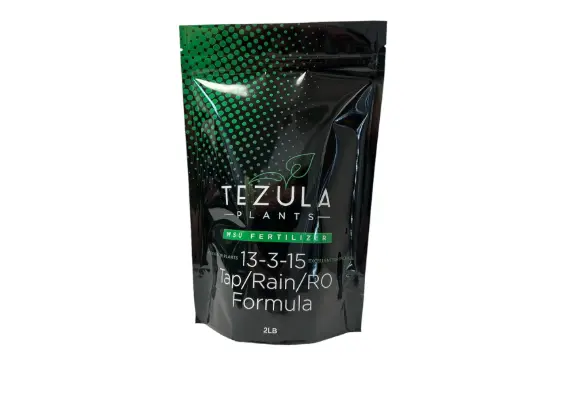
My go-to fertilizer for Dendrobium, Cymbidium, and Vanda orchids.
Mix half a teaspoon in a gallon of water during active growth and 1/4rth teaspoon per gallon during the resting phase.
MSU K-Lite (12-1-1-10Ca-3Mg)
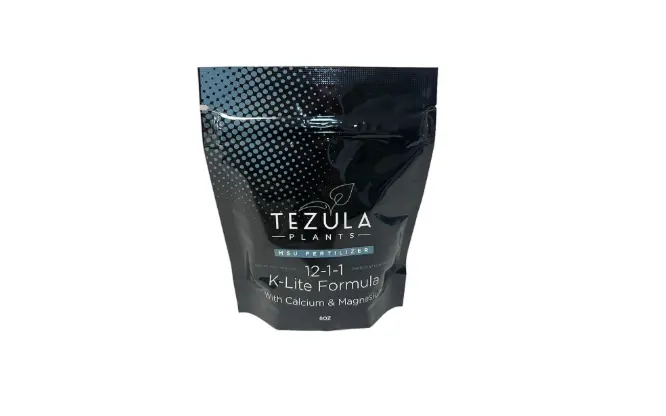
For Paphiopedilum and Phalaenopsis orchids as I found it better for their roots.
Mix half a teaspoon in a gallon of water during active growth and 1/4rth teaspoon per gallon during the resting phase.
Both of them contain calcium, magnesium, zinc, copper, and other micro-nutrients. My orchids love them and bloom consistently. Recently, I’ve noticed a keiki growing on a Phal too. I’ve been using them for years and my plants are doing well.
They’re also easily soluble in water and resealable packaging is a big plus to avoid moisture. Just shake it well, mix the right amount in your tap or RO water, and you’re good to go.
I also use some supplements like Quantum Orchid, Cal/Mag, and MaxSea for my orchids from March to October to get healthy blooms. If you’re starting, just stick to one fertilizer to prevent over-fertilization.
Care for your orchids and enjoy lush and healthy growth!
FAQs
Is Miracle-Gro good for orchids?
Miracle-gro water-soluble is great for reviving dormant orchids and proper dilution is a must for weekly use. The ready-to-use mist works wonders for leaf growth and weak winter fertilization. Slow-release spikes are inexpensive and easy-to-use options for selective orchid varieties.
Can you use Miracle-Gro Orchid food on other plants?
You can use Miracle-gro orchid ferts on other acid-loving plants (not for edible ones). The NPK and other nutrients are needed by all plants. You can experiment for a few weeks and then go for even full strength, depending on the fert requirements of a specific plant.
Can you water with Miracle-Gro daily?
Orchids don’t need daily watering with fertilizers. Stick to providing 75-125ppm N per week. It means water once a week with a pinch or more of fert and you’ll be done for a week.
Does Miracle-Gro Orchid food expire?
No, Miracle-gro won’t go bad even if it’s been sitting around a lot of years. Just store it properly in a sealed container and it’ll be viable for years. The shelf-life is long, and after the expiration date, it may degrade and become less effective.
Is it OK to use Miracle-Gro daily?
No, don’t use them daily as you may over-fertilize your orchids. You can use Miracle-gro mist once a week, water-soluble formula twice a month, and spikes (slow-release) once every two months.
Summing Up
While Miracle-Gro is trusted by many plant lovers, it may not work for every variety and you have to be careful about the concentration you’re feeding.
If you want to try it, go for proper dilution, and application and adjust your orchid’s feeding routine per season. You can then enjoy healthy vegetative growth and lush blooms.
I will keep using the water-soluble formula on one of my Phals and keep you guys posted. It looks promising for now. The mist is great for lazy days when I’m not in the mood for mixing and watering.
That’s all from my side. Just be cautious about concentration and nothing will go wrong!
Have you tried any Miracle-gro orchid ferts? Let me know about your experience in the comments!

